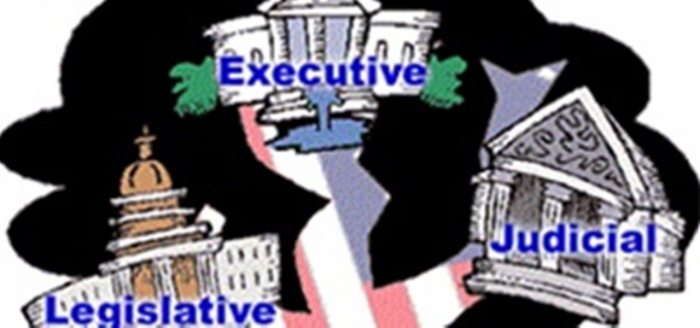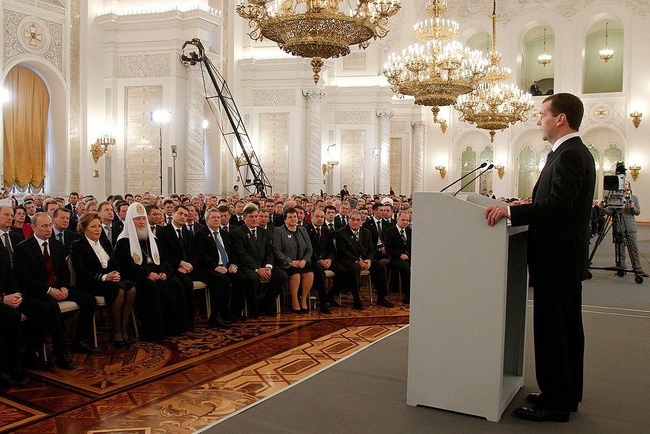Absolutely all world powers exist thanks to power. This power is manifested in the complete control of the higher organs, the elite or even the individual over the country's society. The doctrine of power is familiar to mankind since ancient times. Thanks to power, empires were created and civilizations collapsed, peoples united, and communities died out. Today this term has acquired a completely new meaning. Power has ceased to be violent, inhuman. A citizen of any legal power understands the concept of "power" as the command of the highest state bodies, thanks to which the power functions and is represented on the world stage. State power has a structure, methods and goals of functioning. Moreover, in each country, these factors are built and interact in completely different ways. We will try to understand the principles of state power on the example of the Russian Federation, because it is in this country that one can see a competently constructed structure of the supreme bodies of sovereign functioning. But first of all, you need to understand the history and meaning of the term "power", which has been formed for many centuries in a row by philosophers and lawyers.
Power, political power - the meaning of concepts
Over time the concept of "power" supplemented and modified. In the classical sense, power is the ability to impose one’s own will through leverage. The main feature of power is that the subject of influence will obey the will contrary to his beliefs and resistance. Greek scholars believed that power is the internal desire of society to organize around something or someone. Thus, power will always accompany human development. When the world evolved and people began to build states, political power appeared.

In fact, this is the same ability to impose one’s will, which is owned by a social group, a class in a particular state. The impact is aimed at large groups of people - society. In order to somehow structure the management process, certain mechanisms were created, which, in essence, are the state.
Power sharing
The structure of state power appeared due to the theory put forward by John Locke. He argued that power in a state should be divided into components that would be independent of each other.

Thus, the doctrine appeared that the structure of state power consists of three main elements: executive, legislative and judicial. The method of dividing the sphere of control was first used in Ancient Persia. Over time, he migrated to the political system of Ancient Rome. In any modern legal state, the principle of separation of powers is not new. As for the Russian Federation, the legal climate in this state is developing in step with the times. The structure of state power of the Russian Federation has a classical division into three elements, each of which will be discussed in more detail below. In addition, state power in the person of certain bodies performs a number of functions.
State power: structure and functions
The Constitution of the Russian Federation in detail secured the principle of separation of powers. According to article 10, state power is exercised by dividing into legislative, executive, and judicial. In the same article, the independence of structural elements is indicated. It follows that the state operates on the basis of law and the principle of democratic separation of power into independent branches.Article 11 of the Constitution of the Russian Federation describes the supreme bodies of each structural element of power: the Government of the Russian Federation, the Federal Assembly, the system of courts of the Russian Federation.

Also, the structure of state power contains another element - the president. This institution of constitutional law does not belong to any branch of government and was created only for balance in the system of higher bodies. It should be noted that each of the presented elements must be considered separately, since they all have an internal structure and features.
Executive power in Russia
The structure of government bodies of the Russian Federation is the common name of all bodies, each of which belongs to one or another branch of government. Before considering executive bodies you need to understand what executive power is. Domestic law theorists say that this is a system of special bodies that implement the norms of the constitution, federal laws, and other normative acts in order to maintain the legal climate in the state.

Executive power is needed to implement and control law. There is an opinion that this branch of government is completely dependent on the legislative branch and is under its full control, however this issue is controversial, since the executive authorities are independent in many matters. The structure of the executive bodies of state power is built on the principle of indestructible hierarchy, which allows the most efficient implementation of individual rules of law, laws, the constitution, and other normative acts.
The structure of executive authorities in Russia
As mentioned earlier, the structure of state executive power is built on the principle of hierarchy. In total there are three stages of the organs of this branch. The division is made depending on the subject, who coordinates and regulates their activities.
- Federal ministries and services coordinated by the President of the Russian Federation (Ministry of Internal Affairs, Ministry of Foreign Affairs, Ministry of Defense of the Russian Federation, Ministry of Justice of the Russian Federation, Federal Security Service, Foreign Intelligence Service, FSB).
- Federal ministries and their subordinate bodies, coordinated by the Government of the Russian Federation (Ministry of Health, Ministry of Industry, Ministry of Sports, etc.).
- Agencies and services that report exclusively to the President of the Russian Federation (Migration Service, Customs Service, Federal Service for Nationalities, Space Agency, etc.).
Any activity of these bodies is carried out on the basis of the constitution and federal laws, which are issued by the body representing the legislative branch.
Legislative bodies
The structure of state power in Russia includes, as one of the mandatory elements, the authority to exercise executive power. This term refers to the possibility of government in the field of legislation. In other words, lawmaking is the exclusive right of the organs of this branch. As a rule, one of the organs is vested with legislative power, which, in essence, implements it, puts the mechanism into effect. Also, such bodies have a number of functions, for example: adoption of the state budget, formation or control of the government, ratification of international treaties, declaration, ending the war. In the Russian Federation, the branch of legislative power is implemented through a bicameral parliament, which is called the Federal Assembly.

Federal Assembly: Structure
The Federal Assembly is empowered to legislate (by the legislature) and is also a representative body, as deputies are appointed by popular vote. The Parliament of the Russian Federation consists of two chambers - the upper and lower. The Federation Council consists of 170 senators, who are elected two from each federal subject.Representation from each region, direction and implementation of the strategic goals of the further development of the state are carried out in this chamber. The State Duma is the lower house of the Russian parliament. Every citizen who has reached an electoral age can be elected to it.

The powers and role in the daily life of the state of the Duma are much higher than that of the Federation Assembly. It is the State Duma that can bring charges against the President of the Russian Federation, form the Accounts Chamber, make distrust of the Government, declare amnesties, etc.
Judicial branch
The branch of the judiciary is the most independent branch. The judicial system does not depend on any other authorities. According to this principle, the structure of federal government bodies is built. This allows us to talk about a fair consideration of cases in court, because pressure from other bodies is not produced. The bodies of the judicial system or the judiciary shall carry out the following functions:
- Application of criminal or administrative measures to persons who have committed relevant violations of the law.
- Settlement of disputes between citizens.
- Verification and control of laws for compliance with the Constitution of Russia.
Signs of the judicial authority of the Russian Federation
As we know, the structure of public authorities in Russia is based on democratic principles. The same can be said of the judiciary. It has a number of characteristic features, namely:
- judicial power can be exercised solely by the courts;
- the judiciary does not depend on anyone;
- the judiciary is characterized by a single judicial system that operates on the principle of the rule of law.
The presented signs are fundamental. They appear in the constructed system of judicial instances, which currently operate in Russia.
The judicial system of the Russian Federation
The term “judicial system” itself means a set of special institutions (courts) that are authorized to administer justice. In each country, the court system may be different, because everywhere there is a basic law, customs and a number of other factors affecting the construction of this system. There are four types of courts: general jurisdiction, military, arbitration and the Constitutional Court.

Each authority is authorized to consider only cases subordinate to it. A separate view is the Constitutional Court. He is authorized to monitor and verify regulations for compliance with the Constitution of the Russian Federation, as well as consider constitutional and legal tort. Judges, regardless of the court, can be citizens who have reached a certain age and have a higher education in the field of jurisprudence.
The political regime in Russia
The structure of the highest bodies of state power is an indicator of the political regime. The principles of structuring bodies, their interconnection - all this characterizes the political regime of the state. As we know, with the collapse of the USSR, the Russian Federation is on the path to building a democratic country. It follows that the structure of state power, and in particular bodies, should be based on democratic principles. To date, Russia has achieved positive results, as the authorities operate relatively independently, taking into account mutual regulation. As a result of this, the rule of law reigns, the rights and freedoms of man and citizen are fixed and protected in the constitution. Therefore, we can confidently say that in Russia democratic regime board.
Conclusion
So, we found out what constitutes the structure of state power of the Russian Federation. This complex and rather ramified mechanism is designed to regulate and coordinate public relations within the state, basing its work on the constitution and federal laws.In conclusion, we can conclude that absolutely the entire structure of government bodies of the Russian Federation was created by implementing democratic institutions in the country's legal system.